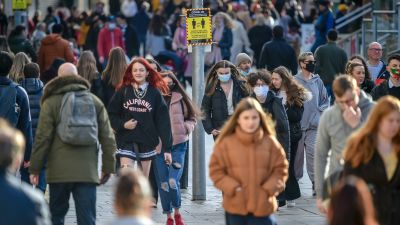Covid alert levels: What needs to happen for Wales to move to level four?

The Welsh Government's 'Coronavirus Control Plan' sets out what the coronavirus restrictions will look like in each of the four alert levels and what conditions would need to be met to move between them.
First Minister Mark Drakeford wrote that the measures are designed to be as simple as possible and that the plan would provide "greater certainty" for people and businesses to allow them to plan for the future.
What are the four alert levels?
Alert level one (low risk): This represents the level of restrictions closest to normality, which are possible while infection rates are low and other preventative measures, such as social distancing and working from home, remain in place.
Alert level two (medium risk): This includes additional controls to limit the spread of coronavirus. These may be complemented by more targeted local actions to manage specific incidents or outbreaks.
Alert level three (high risk): These represent the strictest restrictions short of a firebreak or lockdown. These respond to higher or rising level of infections where local actions are no longer effective in containing the growth of the virus.
Alert level four (very high risk): Restrictions at this level would be equivalent to the firebreak regulations or lockdown. These could either be deployed as a preventative firebreak or as a lockdown measure.
What would need to happen for Wales to go into a lockdown?
The Welsh Government identified several 'key indicators' in their plan that would determine the need to move into a higher alert level.
These include factors such as positivity rates, hospital admission rates and the number of people needing intensive care.
Wales is currently in level three and restrictions equivalent to a lockdown would be brought in if the alert level was raised to four.
Two of the key indicators are a confirmed case rate more than 300 cases per 100,000 people rolling seven-day average and a test positivity above 10% over seven days.
As of December 9, Wales is already exceeding these indicators. The case rate is as high as 450.4 per 100,000 people and 20.40% of tests are returning a positive result.
Other level four indicators identified in the plan include:
Forecast of Welsh population estimated to have COVID-19 is more than 1%.
A reliable estimate of the Reproduction number (Rt) has a lower confidenceinterval of at least 1.
Hospital capacity and likely pressure from increased cases in three weeksexceeding capacity.
Serious concerns from local health professionals not able to manage local issues.
Hospital capacity is already a major concern with the director of the Welsh NHS Confederation having said hospitals in Wales are almost full due to a surge in the number of patients with coronavirus.
Cancel Christmas to avoid 'massive cost in January,' says top Covid doctor
Army should be brought in to help 'massive wave' of Covid in Welsh hospitals
What would restrictions look like in alert level 1?
Schools and businesses would remain open with hospitality able to remain open until 10:20pm and serve alcohol.
People would be able to form bubbles of up to three household and the the rule of six would apply to indoor gatherings - both in homes and public spaces such as restaurants. Under 11s would be excluded from the rule.
Up to 30 people would be allowed to gather outdoors in public spaces whilst only 6 can meet in private gardens.
Places of worship, community centres, gyms, entertain venues and visitor attractions (both indoor and outdoor) would remain open.
Stadiums would be open to spectators although there would be restricted numbers.
There would be travel restrictions to areas of the UK where coronavirus rates are highest but going abroad is allowed.
What would restrictions look like in alert level 2?
The most significant changes to restrictions in level 2 are on gatherings.
Bubbles would be limited to two households with the rule of four introduced to indoor and outdoor meetings.
Hospitality businesses would stay open but would only be able to serve alcohol between 6am and 10pm where it is part of a substantial meal.
Education would remain open but Universities would move to a mixture of in person and remote learning.
Sporting events would continue but they would but closed to crowds.
What would restrictions look like in alert level 3?
You can only meet your extended household in your home and private gardens but you can meet with four people from different households in a restaurant or pub.
Non-essential shops, hairdressers and gyms can all remain open but hospitality businesses cannot serve alcohol and must close by 6pm.
Travelling is not allowed to areas of high prevalence and international travel is not advised.
Up to 30 people can meet for organised exercise outside but only 15 can do so inside.
Wedding ceremonies and funerals can continue with receptions limited to 15 people indoors and 30 outdoors.
The restrictions do not apply to restrictions for children and schools will remain open.
What would restrictions look like in alert level 4?
People would have to stay at home and only mix with people in their household or support bubble
Non-essential shops, gyms, hairdressers, hospitality businesses and holiday accommodation would have to close and only essential travel would be allowed.
Indoor and outdoor attractions would be closed but wedding ceremonies and funerals could continue with limited numbers and without a reception or wake.
Schools, places of worship and parks would remain open.